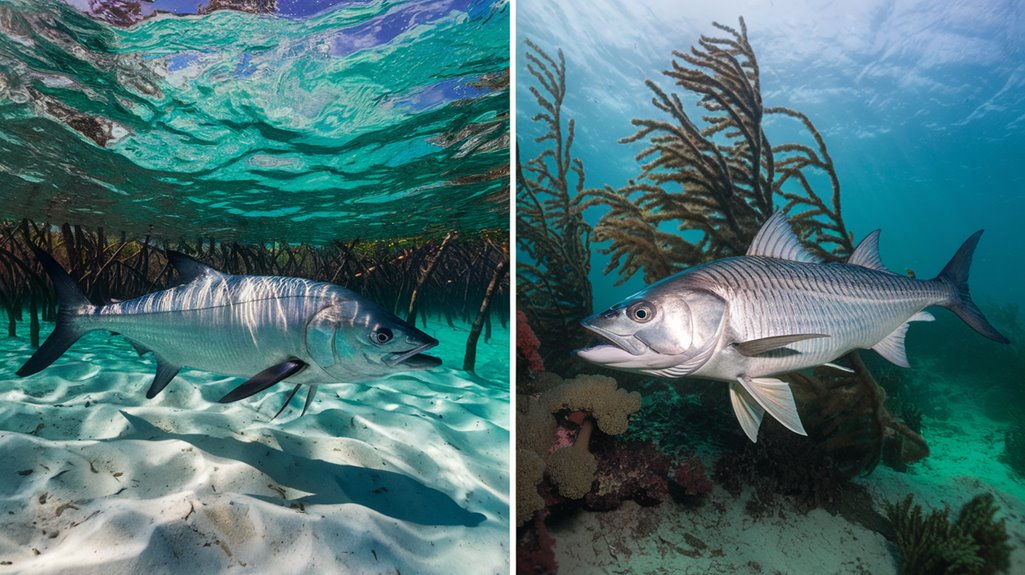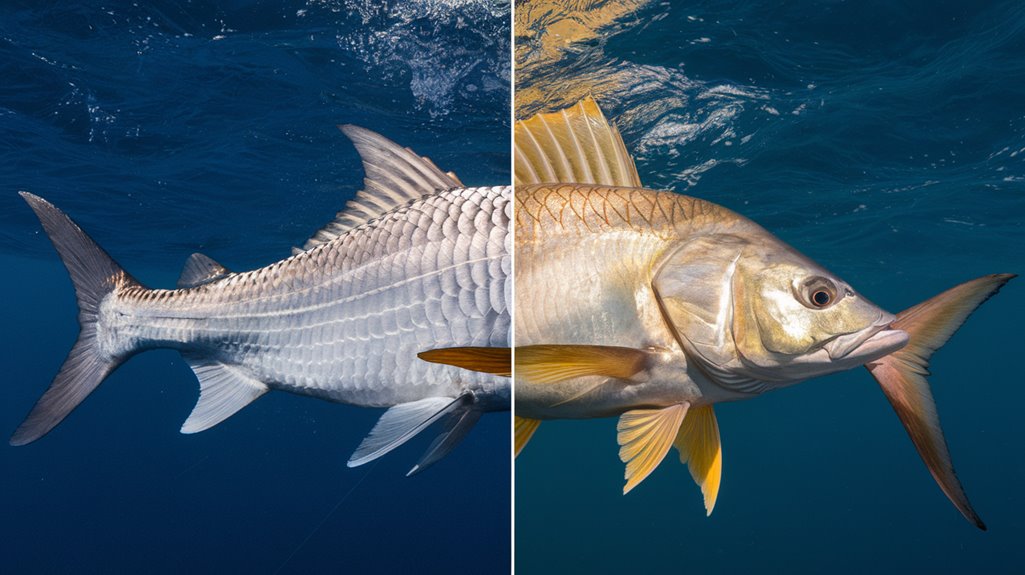You'll find remarkable distinctions between the two extant species of the genus *Megalops*, despite their shared ancestral lineage. The Atlantic tarpon (*M. atlanticus*) and Indo-Pacific tarpon (*M. cyprinoides*) have evolved distinct morphological and behavioral characteristics that reflect their adaptation to different marine ecosystems. These differences extend beyond mere size variations, encompassing their habitat preferences, migration patterns, and feeding strategies. Understanding these contrasts reveals fascinating insights into their evolutionary divergence.
Key Takeaways
- Atlantic tarpon grows significantly larger, reaching 8 feet and 300 pounds, while Indo-Pacific tarpon maxes at 5 feet and 40 pounds.
- Atlantic tarpon is exclusively marine-dwelling, while Indo-Pacific tarpon adapts to both freshwater and saltwater environments.
- Atlantic tarpon undertakes extensive migrations up to 1,200 miles, whereas Indo-Pacific tarpon stays within 100-mile local ranges.
- Indo-Pacific tarpon spawns biannually in coastal areas, while Atlantic tarpon forms large offshore spawning aggregations during warmer months.
- Atlantic tarpon has a robust body shape, while Indo-Pacific tarpon is more elongated with a distinctive extended dorsal fin ray.
Physical Characteristics and Appearance

The two extant species of tarpon exhibit distinct morphological differences, with Megalops atlanticus demonstrating markedly larger proportions than its Indo-Pacific relative, M. cyprinoides. You'll find the Atlantic tarpon reaching impressive dimensions of up to 8 feet and 300 pounds, while its Indo-Pacific counterpart maxes out at 5 feet and 40 pounds.
When examining physical characteristics, you'll notice the Atlantic tarpon's robust body contrasts with the Indo-Pacific tarpon's more elongated form. Both species display silver coloration, though M. atlanticus's larger size has earned it the "silver king" moniker. The Indo-Pacific tarpon's extended last dorsal fin ray and pronounced bony plate in its upturned mouth serve as key distinguishing features from its Atlantic relative.
Size Variations and Growth Patterns
While both species display distinct growth trajectories, Megalops atlanticus exhibits considerably greater size potential, reaching dimensions three times larger than M. cyprinoides in ideal conditions. You'll find that habitat greatly influences these size variations, with Atlantic tarpon thriving in saltwater environments to achieve larger size, while Indo-Pacific tarpon remain smaller in freshwater habitats.
| Characteristic | Atlantic Tarpon | Indo-Pacific Tarpon |
|---|---|---|
| Maximum Length | 8+ feet | 5 feet |
| Typical Weight | 100 pounds | 40 pounds |
| Sexual Maturity | 2 feet | 2 feet |
| Growth Rate | Slower in captivity | Multiple months |
Growth patterns between these species diverge markedly after reaching sexual maturity. The Atlantic tarpon's extended growth period results in more substantial size gains, whereas the Indo-Pacific tarpon maintains a more modest growth trajectory, typically maturing within two years.
Geographic Distribution and Habitat

Beyond their size distinctions, both Megalops species maintain distinct geographic ranges that shape their evolutionary adaptations. You'll find Atlantic tarpon (M. atlanticus) exclusively in the Atlantic Ocean, ranging along North and South America's coasts and extending to Africa. In contrast, Indo-Pacific tarpon (M. cyprinoides) inhabit a vast range from East Africa through Southeast Asia to southern Australia.
The species' habitat preferences also differ considerably. While Atlantic tarpon prefer saline environments, their Indo-Pacific counterparts display remarkable adaptability through amphidromous migration patterns, thriving in both freshwater rivers and marine environments. You'll notice Indo-Pacific tarpon frequently utilizing brackish backwaters during their juvenile stage, whereas Atlantic tarpon juveniles typically migrate to estuaries. This habitat flexibility has enabled Indo-Pacific tarpon to become abundant throughout their extensive distribution in coastal areas.
Feeding Behavior and Diet
You'll find distinct feeding preferences between Atlantic tarpon (Megalops atlanticus) and Indo-Pacific tarpon (Megalops cyprinoides), with the former primarily targeting herring and prawns in saltwater environments, while the latter demonstrates greater dietary flexibility across both fresh and brackish waters. These species employ different hunting techniques, as Indo-Pacific tarpon's ability to survive in low-oxygen conditions enables them to pursue prey in environments inaccessible to their Atlantic relatives. The seasonal movements of Atlantic tarpon coincide with prey availability during offshore spawning migrations, whereas Indo-Pacific tarpon maintain more consistent feeding patterns throughout their range.
Preferred Prey By Species
Two distinct feeding patterns characterize Atlantic and Indo-Pacific tarpon species, though both share opportunistic predatory behavior. You'll find Atlantic tarpon primarily targeting marine prey in coastal waters, while Indo-Pacific tarpon demonstrate greater dietary flexibility across both saltwater and freshwater environments.
Key differences in preferred prey include:
- Atlantic tarpon focus on marine species like herring and mullet
- Indo-Pacific tarpon regularly consume freshwater prawns and bony bream
- Both species feed on crustaceans, with Atlantic favoring marine crabs
- Indo-Pacific show broader habitat adaptation in prey selection
Both species utilize their distinctive upturned mouths and small teeth to swallow prey whole, employing rapid swimming and dramatic leaps during hunting. Their feeding behaviors reflect evolutionary adaptations to their respective habitats, with Indo-Pacific tarpon showing greater versatility in prey selection.
Hunting Patterns and Techniques
While both tarpon species share fundamental hunting strategies, their distinct feeding behaviors reflect specialized adaptations to their respective environments. You'll find Atlantic tarpons employing varied feeding techniques in saltwater habitats, primarily targeting schools of herring, while Indo-Pacific tarpons demonstrate remarkable adaptability between marine and freshwater environments, focusing on crustaceans and bream. Both species use their distinctive upturned mouths to swallow prey whole, but their juvenile stages show different hunting patterns. Young Indo-Pacific tarpons excel in low-oxygen waters, accessing prey that other species can't reach, while juvenile Atlantic tarpons prefer estuarine feeding grounds. Their migratory behaviors also influence hunting patterns, with both species shifting from inshore to offshore feeding grounds as they mature, though timing varies between them.
Seasonal Diet Variations
Seasonal fluctuations in water temperature and prey availability drive distinct dietary patterns between Atlantic and Indo-Pacific tarpon. You'll notice that Atlantic tarpon exhibit more pronounced feeding variations, focusing on herring and crustaceans during warmer months while often requiring migration to maintain access to prey in colder periods.
Here's how seasonal diet variations affect both species:
- Indo-Pacific tarpon maintain relatively consistent feeding patterns, adapting to local prey like prawns and bony bream
- Atlantic tarpon increase their feeding activity during summer months when metabolic rates peak
- Water temperature directly influences prey density and feeding frequency for both species
- Atlantic tarpon's migration patterns align with prey school movements, especially during spawning seasons
These variations demonstrate how each species has evolved distinct feeding strategies to optimize their survival in different marine environments.
Migration and Spawning Patterns
Despite sharing taxonomic classification within the genus Megalops, Atlantic tarpon (M. atlanticus) and Indo-Pacific tarpon (M. cyprinoides) exhibit distinct migratory behaviors and spawning patterns. You'll find Atlantic tarpon undertaking extensive migrations up to 1,200 miles along North America's eastern coast, while Indo-Pacific tarpon maintain localized movements within 100-mile ranges. Atlantic tarpon's spawning activities occur primarily offshore during warmer months, with juveniles moving to estuaries nocturnally. In contrast, Indo-Pacific tarpon spawn biannually in coastal areas and demonstrate remarkable adaptability to varying salinities in both freshwater and saltwater breeding environments. Their reproductive capabilities allow both species to spawn across different salinity gradients, though Atlantic tarpon form more prominent offshore spawning aggregations compared to their Indo-Pacific counterparts.
Adaptations for Survival

The morphological and physiological adaptations of Megalops species showcase remarkable evolutionary divergence between Atlantic and Indo-Pacific populations. You'll find that Atlantic tarpon have evolved to be considerably larger, reaching 8 feet and 300 pounds, while their Indo-Pacific counterparts remain under 5 feet and 40 pounds.
Both species display critical survival adaptations through their swim bladder functionality:
- Oxygen absorption capabilities in low-oxygen environments
- Dual-purpose organs serving as both buoyancy control and modified lungs
- Enhanced tolerance for freshwater habitats
- Adaptability to varying salinity levels for spawning
The Atlantic tarpon's extensive migratory behavior, covering distances up to 1200 miles, contrasts with the Indo-Pacific's localized habitat preferences, demonstrating distinct evolutionary strategies for survival in their respective environments.
Conservation Status and Population Trends
You'll find that Atlantic tarpon (Megalops atlanticus) and Indo-Pacific tarpon (Megalops cyprinoides) face distinct conservation challenges, with the Atlantic species maintaining stable populations in managed regions while experiencing localized declines where fishing pressure is high. Both species confront threats from coastal development, habitat loss, and environmental shifts that could destabilize their populations over time. While Atlantic tarpon benefit from established sport fishing regulations and monitoring programs, Indo-Pacific tarpon lack thorough population data and formal protection measures across much of their range.
Population Threats and Declines
While both Atlantic (Megalops atlanticus) and Indo-Pacific tarpon (Megalops cyprinoides) face mounting pressures on their populations, conservation measures and monitoring efforts differ considerably between regions. You'll find that habitat degradation poses a significant threat to both species, particularly affecting their breeding grounds and areas vital for juvenile development.
The primary threats to tarpon populations include:
- Overfishing and unsustainable harvesting practices
- Coastal development destroying essential nursery habitats
- Environmental changes impacting traditional breeding grounds
- Pollution affecting estuarine environments important for survival
While Atlantic tarpon benefit from strict regulations and thorough population data, Indo-Pacific tarpon lack sufficient monitoring systems. Conservation efforts now focus on implementing sustainable fishing practices and habitat restoration projects to guarantee both species' long-term survivability across their respective ranges.
Regional Protection Measures
Despite sharing similar evolutionary lineages, Atlantic and Indo-Pacific tarpon populations experience markedly different levels of protection and monitoring across their respective ranges. You'll find that Atlantic tarpon (Megalops atlanticus) benefits from well-established conservation measures, particularly in Florida and the Caribbean, where strict fishing regulations and catch-and-release practices help maintain stable populations. In contrast, Indo-Pacific tarpon (Megalops cyprinoides) faces varying levels of regional protections across its South Asian and Australian range. While Atlantic tarpon populations are consistently monitored and show resilience, the Indo-Pacific species suffers from significant data deficiencies, making it challenging to implement effective conservation strategies. The lack of thorough population data, combined with ongoing threats from habitat loss and overfishing, highlights the urgent need for enhanced protection measures for Indo-Pacific tarpon.
Frequently Asked Questions
What Is the Difference Between Atlantic Tarpon and Indo Pacific Tarpon?
You'll find Atlantic tarpon (Megalops atlanticus) reaches larger sizes, exceeding 300 pounds, while Indo-Pacific tarpon (Megalops cyprinoides) remains smaller at 40 pounds, with distinct spawning behaviors and habitat preferences.
What Are the Characteristics of the Indo Pacific Tarpon?
You'll find M. cyprinoides characterized by its olive-green dorsal coloring, silver flanks, upturned mouth with elongated lower jaw plate, modified swim bladder for oxygen absorption, and 5-foot maximum length.
How Big Do Indo-Pacific Tarpons Get?
You'll find Indo-Pacific tarpons reaching up to 5 feet in marine environments, though freshwater specimens typically max out at 20 inches. Their maximum recorded weight is approximately 40 pounds.
How Big Can Atlantic Tarpon Get?
You'll find Atlantic tarpon (Megalops atlanticus) typically reaching 6-8 feet in length and weighing up to 300 pounds, though most adults stay under 100 pounds in natural conditions.
Conclusion
You'll find that *Megalops atlanticus* and *M. cyprinoides* represent distinct evolutionary adaptations within their genus. While they share ancestral traits like air-breathing capabilities and elopiform characteristics, they've diverged markedly in morphology, behavior, and ecological niches. The Atlantic species exhibits greater size dimorphism and migratory tendencies, while its Indo-Pacific counterpart demonstrates enhanced habitat plasticity and dietary diversification. These differences underscore their specialized adaptations to regional environmental pressures.

